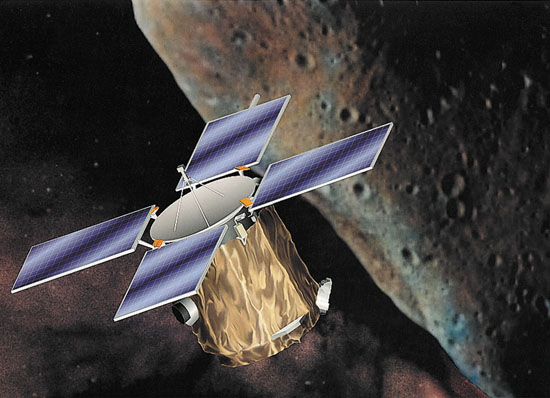[/caption]
Remember a competition we reported on back in April called "
Move An Asteroid"?
It was an international technical paper competition looking for unique and innovative concepts for how to deflect an asteroid or comet that might be on a collision course for Earth. The winners have been announced and first prize went to Australian PhD student Mary D'Souza who came up with quite a novel concept: wrap the asteroid with reflective sheeting. Such a coating may increase the asteroid’s reflectivity, enabling deflection by solar radiation pressure.
The asteroid in question, known as Apophis, will pass close to Earth in 2029. Although the 207 meter- wide Apophis is not expected to impact Earth, its current trajectory has it approaching Earth no closer than 29,470 km (18,300 miles), which is well inside the orbit of the moon. This, in conjuction with the 100th anniversary of the Tunguska explosion, was the impetus behind the competition.
D'Souza's paper was titled "A Body Solar Sail Concept for the Deflection of 99942 Apophis." Her concept involves using a satellite orbiting Apophis to wrap it with ribbons of reflective Mylar sheeting. Covering just half of the asteroid would change its surface from dull to reflective, possibly enough to allow solar pressure to change the asteroid's trajectory.
"What happens then is light from the sun shines on the body [of the asteroid] so more of it is reflected ... and it actually acts to move it away from the sun and the earth," said D'Souza, a student at University of Queensland's School of Engineering.
The competition was sponsored by the Space Generation Advisory Council, a group representing youth perspectives on space exploration to the United Nations and national space programs. SGAC said they received submissions to the competition from all over the world. "It is great to see such an interest in this topic from young people all over the world. Hopefully with competitions like this, SGAC can further increase the involvement of youth in this important field of current space research," said Alex Karl, Co-Chairperson of the SGAC.
By winning the competition, D'Souza will travel to Glasgow at the end of September to present her plan at the International Astronautical Congress.
Second place was awarded to Andrew Bacon of the Department of Electronic and Electrical Engineering at the University of Bath for his paper entitled "The Use of Electromechanical Resonators for the Mitigation of Earth Threatening Asteroids and Comets." Bacon’s concept involves the use of electromechanical resonators to build up waves within an asteroid or comet that would break it up. He will also present his plan at the IAC.
Sources: Space Generation press release,
The Register
 Universe Today
Universe Today
